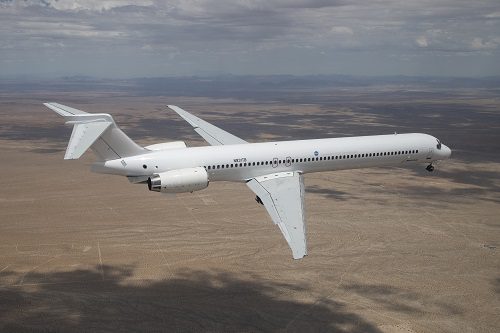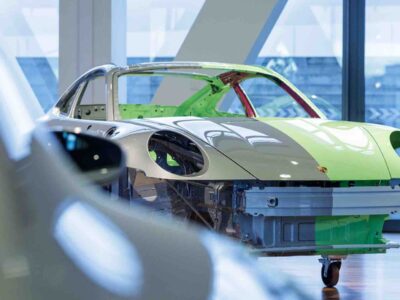Boeing and NASA have teamed up to create a more eco-friendly airliner that doesn’t burn through fuel as quickly. Boeing’s Sustainable Flight Demonstrator project is advancing into its engineering stage. The company and agency announced that an MD-90 plane flew to Palmdale, CA, and will be transformed into the X-66A, an experimental aircraft with new wings that reduce fuel burn.
The X-66A will be the first experimental plane centered around net-zero greenhouse gas emissions. A combination of thinner wings with large bracing struts attached could reduce fuel use and emissions by 30%, Boeing said in a statement.
Modifications are expected to take at least five years. Test flights won’t be conducted until 2028 at the earliest.
It’s part of the Subsonic Ultra Green Aircraft Research (SUGAR) Program, a joint venture between Boeing and NASA to develop climate-friendly aircraft.
“This marks an important step in the Sustainable Flight Demonstrator project, advances Boeing’s commitment to sustainability, and brings us closer to testing and validating the TTBW design,” Todd Citron, Boeing’s chief technology officer, said in a press release.

Photo Courtesy Boeing
There is a lot of hype around Boeing’s Transonic Truss-Braced Wing (TTBW). The concept came to be in 2010 as a higher-efficiency airliner idea. NASA has been involved with the TTBW’s development since the beginning.
The first public schematics of the wings were revealed in 2019 and are now ready to be tested. The TTBW design makes a plane more aerodynamic and lighter and has better-cruising properties. “Simply Flying” says TTBW planes can reach Mach 0.80, which is as fast as current jets.
Wind tunnel tests showed the wings could reach 9–10% reduced fuel consumption by themselves. NASA and Boeing hope for a 30% reduction thanks to a slimmer plane body. It also has a large wingspan, which could make storing them difficult. Boeing plans to add folding wings on TTBW jets, allowing them to be placed in hangars without taking up extra space.
NASA notes in a video on TTBW tests that these jets are quieter in addition to being less impactful on the atmosphere.
The space agency has committed more than $425 million in funding across the next seven years to get the X-66A created and into testing. Boeing is picking up the rest of the tab.
“It’s our goal that NASA’s partnership with Boeing to produce and test a full-scale demonstrator will help lead to future commercial airliners that are more fuel efficient, with benefits to the environment, the commercial aviation industry, and to passengers worldwide,” said Bill Nelson, NASA administrator, in a press release. “If we are successful, we may see these technologies in planes that the public takes to the skies in the 2030s.”

Photo Courtesy NASA/Joel Kowsky
NASA has been working with the private sector to innovate more sustainable aviation solutions. The space agency is giving companies access to aeronautical expertise and facilities companies didn’t have access to. The Funded Space Act Agreements allow NASA to provide Boeing and its partners with money for these endeavors.
The X-66A has earned its experimental aircraft status from the Air Force ahead of its test flight. We may see these TTBW planes in public airlines as early as 2030, with a more aggressive rollout toward 2035.
“We at NASA are excited to be working with Boeing on the X-66A Sustainable Flight Demonstrator making critical contributions to accelerate aviation towards its 2050 net-zero greenhouse gas emission goal,” Ed Waggoner, deputy associate administrator for programs in the NASA Aeronautics Research Mission Directorate, said in a press release.





